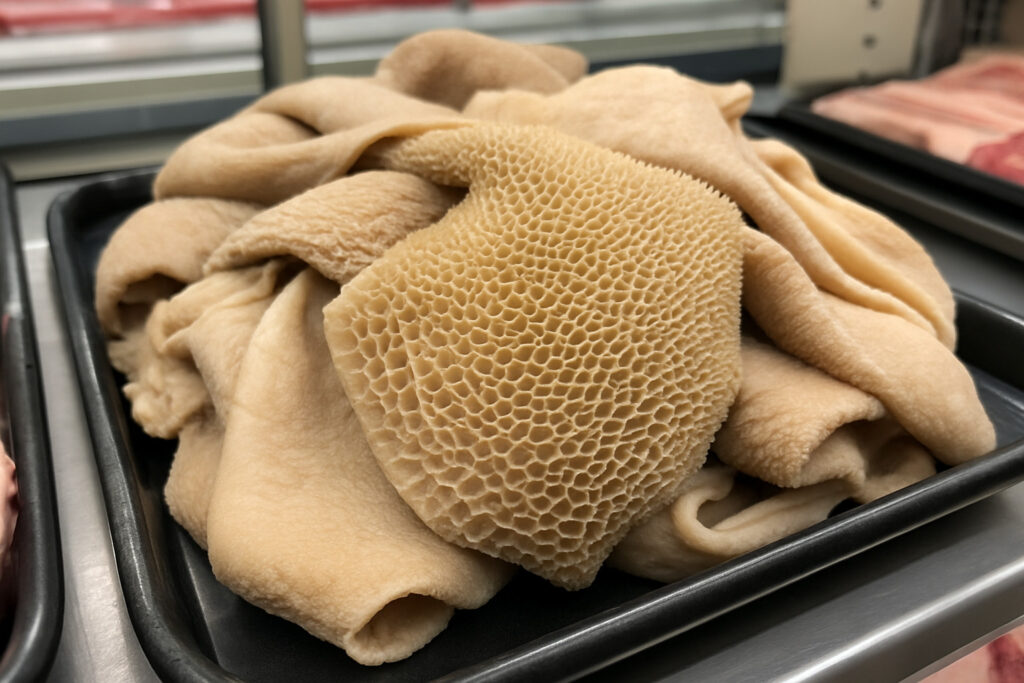Understanding What Is Tripe Meat
What is tripe meat is a question many adventurous food lovers ask when exploring global cuisines. Simply put, tripe is the edible stomach lining of ruminant animals like cows, sheep, and goats.
Quick Answer:
- Source: Stomach lining of farm animals (mainly cattle)
- Types: Four varieties from different stomach chambers
- Texture: Chewy, absorbs flavors well
- Nutrition: High protein, low fat, rich in B12
- Uses: Soups, stews, braised dishes worldwide
As my grandmother taught me, “try everything at least once” – and tripe perfectly embodies this adventurous eating philosophy. This often-misunderstood ingredient has fed communities across continents for centuries, from Mexican menudo to Italian trippa alla romana.
Why does tripe matter today? With the rise of nose-to-tail eating and sustainable dining practices, this affordable protein source reduces food waste while delivering impressive nutrition. A 3-ounce serving packs 10 grams of protein and 58% of your daily vitamin B12 needs.
Many people initially feel hesitant about tripe’s texture and preparation process. But once you understand its mild flavor and ability to absorb surrounding spices and aromatics, you’ll see why cultures worldwide consider it comfort food.
Whether you’re exploring authentic street food in New York City or planning your next culinary trip, understanding tripe opens doors to traditional dishes you might otherwise skip.
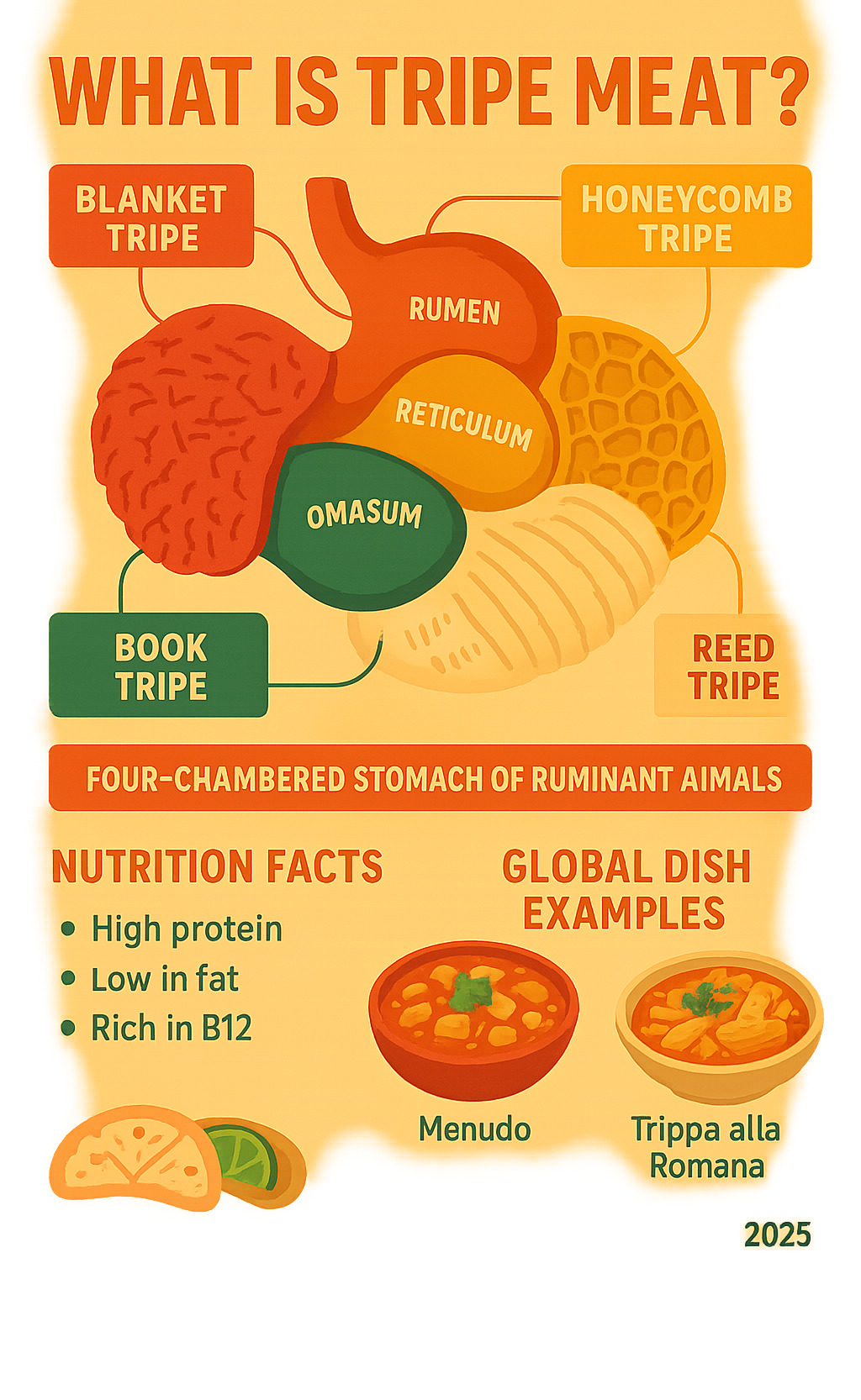
What Is Tripe Meat?
When someone asks what is tripe meat, they’re finding one of the world’s most traditional yet misunderstood ingredients. Tripe is the edible stomach lining from ruminant animals – those grass-eating creatures like cows, sheep, and goats that have special multi-chambered stomachs designed to break down tough plant fibers.
Think of it this way: while we humans have one simple stomach, these animals are equipped with a sophisticated four-part digestive system. The tripe we eat comes from the muscular walls of these chambers, carefully cleaned and processed to remove the inner mucosal lining.
Most tripe meat you’ll find in stores comes from cattle, though adventurous cooks can also find sheep, goat, and buffalo varieties. The meat industry transforms raw tripe through cleaning, trimming, boiling, and bleaching – which is why store-bought tripe appears white and is called “dressed” tripe.
Anatomical Source of What Is Tripe Meat
Understanding what is tripe meat becomes fascinating when you learn about ruminant anatomy. Each of the four stomach chambers produces its own distinct type of tripe, with unique textures and cooking properties.
The rumen serves as the first and largest chamber, working like a natural fermentation tank where grass begins its breakdown process. This chamber gives us blanket tripe or flat tripe, which has a smooth, relatively flat appearance that’s perfect for hearty stews.
Moving to the reticulum, we find the source of the most beloved variety – honeycomb tripe. This second chamber creates the distinctive hexagonal pattern that looks exactly like a bee’s honeycomb. Cooks prize honeycomb tripe for its tender texture and incredible ability to soak up flavors from broths and sauces.
The omasum acts as nature’s filter, straining food particles before they continue their journey. This third chamber produces book tripe or bible tripe, named for its layered, leaf-like appearance that resembles pages in a book.
Finally, the abomasum functions most like our human stomach, using acids to break down food. This fourth chamber creates reed tripe, though you’ll rarely see this variety in restaurants since it’s more commonly used for rennet production in cheese-making.
Animals and Types of Tripe Meat
While beef tripe dominates about 90% of the commercial market, different animals offer their own special characteristics that various cuisines have celebrated for generations.
Cattle tripe wins popularity contests for good reason – it’s large, has consistent texture, and offers that mild flavor that readily welcomes whatever spices and seasonings you throw at it. Whether you’re making Mexican menudo or Italian trippa, beef tripe provides the perfect canvas.
Sheep tripe brings a more delicate approach to the table. Smaller and more tender than its beef cousin, it cooks faster and carries a slightly more pronounced flavor that Mediterranean and Middle Eastern cooks have mastered in their traditional recipes.
Goat tripe takes things up another notch with even more intense flavor, making it the star ingredient in Caribbean, African, and South Asian kitchens where bold tastes are celebrated.
Buffalo tripe offers health-conscious cooks a leaner option with firmer texture, though you’ll need to seek out specialty suppliers since it’s not widely available in most markets.
It’s worth noting that pork maw (pig stomach) often gets grouped with tripe, even though pigs aren’t ruminants. This ingredient appears in dishes like Pennsylvania Dutch hog maw and various Asian preparations, prepared using similar techniques to true tripe.
Nutritional Profile & Health Considerations
When exploring what is tripe meat from a nutrition standpoint, you’ll find this humble organ meat punches well above its weight class. I remember my first encounter with tripe’s nutritional profile – I was genuinely shocked by how much nutrition was packed into such an affordable cut.
A 5-ounce (140-gram) serving of cooked beef tripe delivers approximately 125 calories and 18 grams of high-quality protein with only 5 grams of fat. But here’s where it gets really interesting: that same serving provides a whopping 64% of your daily vitamin B12 needs, plus 33% of selenium requirements and 19% of zinc needs.
The mineral content continues to impress. Tripe provides meaningful amounts of iron (0.59 mg per 100g) for oxygen transport, calcium (69 mg per 100g) for strong bones, and phosphorus (64 mg per 100g) for energy metabolism. You’ll also get potassium for heart health and magnesium for proper muscle function.
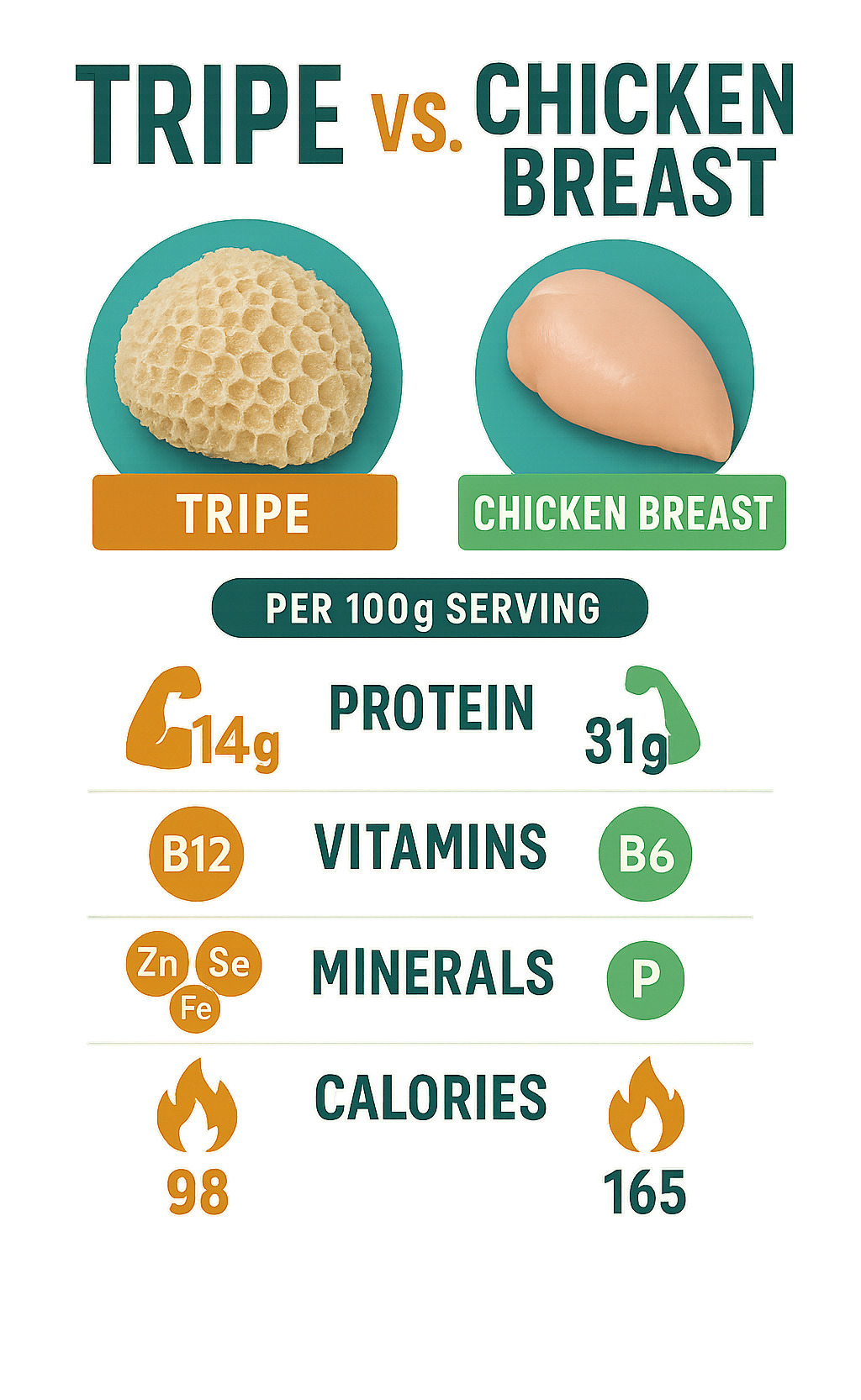
According to scientific research on tripe nutrition, this organ meat stands out for its complete amino acid profile, making it particularly valuable for muscle building and repair.
Health Benefits of Tripe
The complete amino acid profile in tripe makes it a powerhouse for anyone looking to build or maintain muscle mass. Unlike some protein sources that leave you searching for complementary foods, tripe delivers all the essential amino acids your body needs in one package.
For weight management support, tripe becomes your secret weapon. With only 85 calories per 100 grams, it offers substantial protein that keeps you feeling full without breaking your calorie budget. That high protein content naturally reduces appetite and helps curb those late-night snacking urges we all know too well.
The anemia prevention benefits are particularly impressive. That exceptional vitamin B12 content (58% daily value per 100g) makes tripe especially valuable for preventing megaloblastic anemia. Getting B12 through whole food sources like tripe often improves absorption compared to synthetic supplements.
Tripe’s antioxidant properties come primarily from its selenium content, which acts as a powerful defender against cellular damage. This mineral supports immune function, may reduce inflammation, and plays crucial roles in thyroid health and heart disease prevention.
The combination of calcium, phosphorus, and protein in tripe creates a trifecta for bone health support. This becomes increasingly important as we age and our bones naturally begin losing density.
Possible Risks & Who Should Limit Intake
Despite these impressive benefits, understanding what is tripe meat means acknowledging some considerations. A 5-ounce serving contains 178 mg of cholesterol – about 59% of the traditionally recommended daily limit of 300 mg.
Cholesterol concerns primarily affect people with existing high cholesterol or those who are “cholesterol hyper-responders.” If you fall into these categories, definitely chat with your healthcare provider before making tripe a regular part of your diet. The good news? Recent research shows dietary cholesterol affects blood cholesterol less dramatically than we once believed for most people.
Texture aversion presents the most common challenge for newcomers to tripe. That distinctive chewy, somewhat rubbery texture can be off-putting, especially for people with dental issues or jaw problems. However, proper cooking techniques can significantly minimize this concern.
Food safety requires the same careful attention you’d give any organ meat. Always purchase from reputable sources, ensure proper storage, and cook thoroughly. The payoff for this extra care is a nutritious, flavorful ingredient that connects you to culinary traditions worldwide.
Cleaning, Preparation & Safe Handling
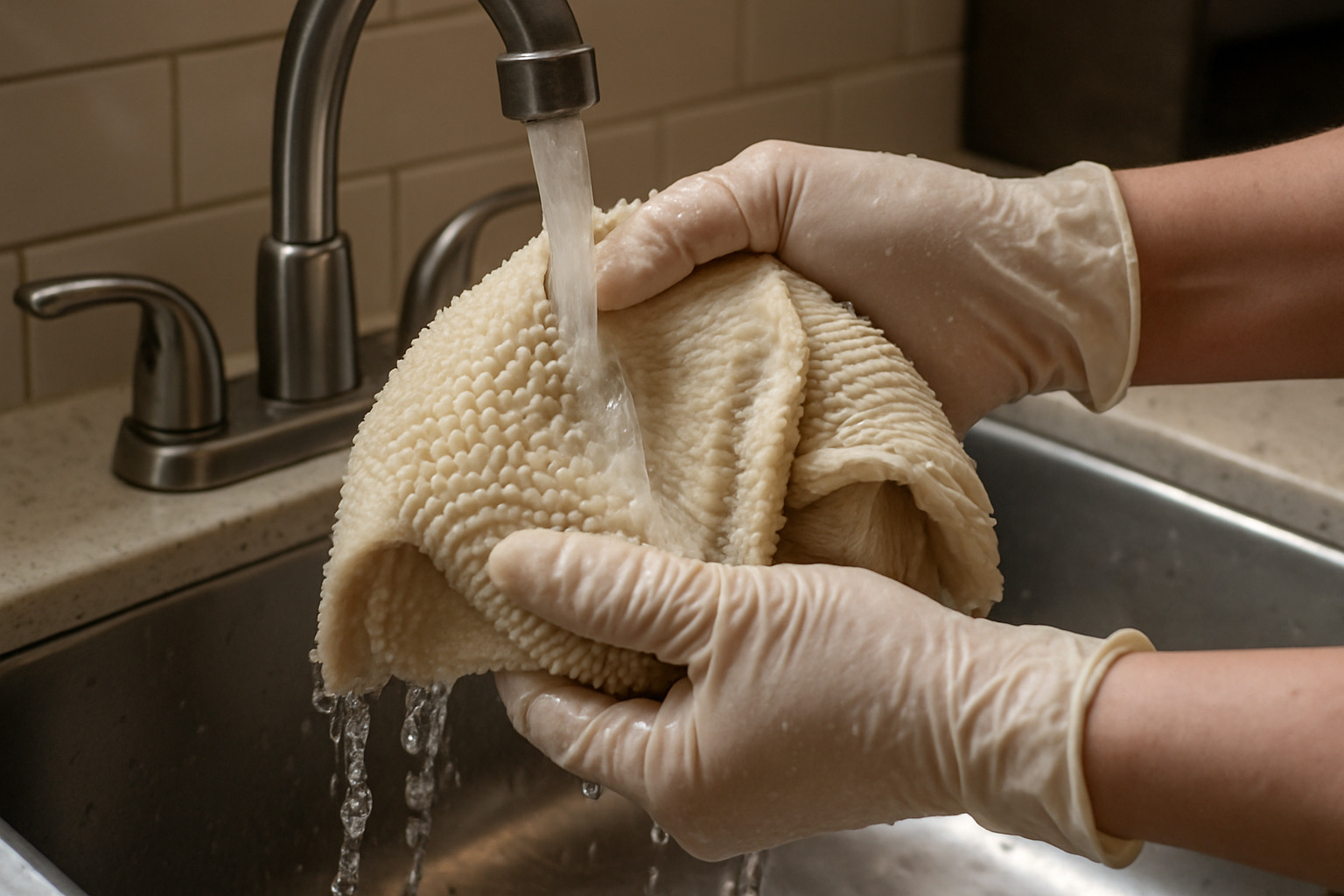
Learning to properly handle what is tripe meat might seem intimidating at first, but it’s actually simpler than many people think. The good news? Most tripe you’ll find in American supermarkets has already done the heavy lifting for you.
When you purchase tripe from a grocery store, you’re getting what’s called “dressed” tripe. This means it’s been professionally cleaned, soaked in a chlorine solution to remove odors, and partially cooked. The USDA inspection process ensures all commercially sold tripe meets safety standards, so you can shop with confidence.
That characteristic white appearance comes from the bleaching process – don’t worry, it’s completely safe and actually makes your job much easier. Fresh dressed tripe should feel firm but flexible, with a clean smell rather than any barnyard odors.
Step-by-Step Cleaning Guide
Even dressed tripe needs some attention before cooking. The difference between dressed and green tripe is significant – green tripe is completely unprocessed and requires extensive cleaning that most home cooks prefer to avoid.
For dressed tripe, start with a thorough rinse under cold running water. This removes any residual chlorine and surface debris. Take your time here – good rinsing makes a noticeable difference in the final taste.
Next comes the trimming phase. Use a sharp knife to remove any excess fat or tough membrane areas. Don’t worry about being perfect – a little fat actually adds flavor during cooking. Cut the tripe into pieces sized for your recipe, whether that’s strips for frying or chunks for stewing.
If you encounter green tripe, the odor removal process requires patience. The traditional salt-vinegar soak method works best – scrub the tripe with coarse salt and white vinegar, then soak in ice water with more salt and vinegar for thirty minutes. After scrubbing again, blanching in boiling water for fifteen minutes helps eliminate any remaining strong smells.
Cooking Techniques & Texture Tips for What Is Tripe Meat
The secret to understanding what is tripe meat becomes during cooking lies in embracing slow, gentle methods. Think of tripe as the ultimate comfort food ingredient – it rewards patience with incredible flavor absorption and satisfying texture.
Simmering remains the gold standard for tripe preparation. Plan for 1-4 hours of boiling depending on your recipe and desired tenderness. The beauty of simmering is how tripe transforms from chewy to tender while soaking up every flavor in your cooking liquid. Add aromatic vegetables like onions, carrots, and celery early in the process.
Modern cooks love pressure-cooking for its time-saving benefits. What normally takes hours can be accomplished in 45-60 minutes under pressure. This technique works particularly well for weeknight dinners when you’re craving traditional tripe dishes but short on time.
Braising offers the best of both worlds – you get the deep flavors from browning the tripe first, then the tender results from slow cooking in liquid. This method works beautifully for hearty winter stews.
For something completely different, try deep-frying pre-cooked tripe. Cut it into strips, bread it, and fry until golden. This Southern technique creates an unexpectedly delicious crispy exterior while maintaining that characteristic bouncy interior.
Tripe is nearly impossible to overcook but very easy to undercook. When properly prepared, it should have a pleasant, slightly bouncy texture that’s neither rubbery nor mushy. The change is remarkable – what starts as intimidating becomes incredibly satisfying.
For more detailed guidance on traditional preparation methods from around the world, check out our authentic local food guides.
Global Cuisines & Popular Dishes
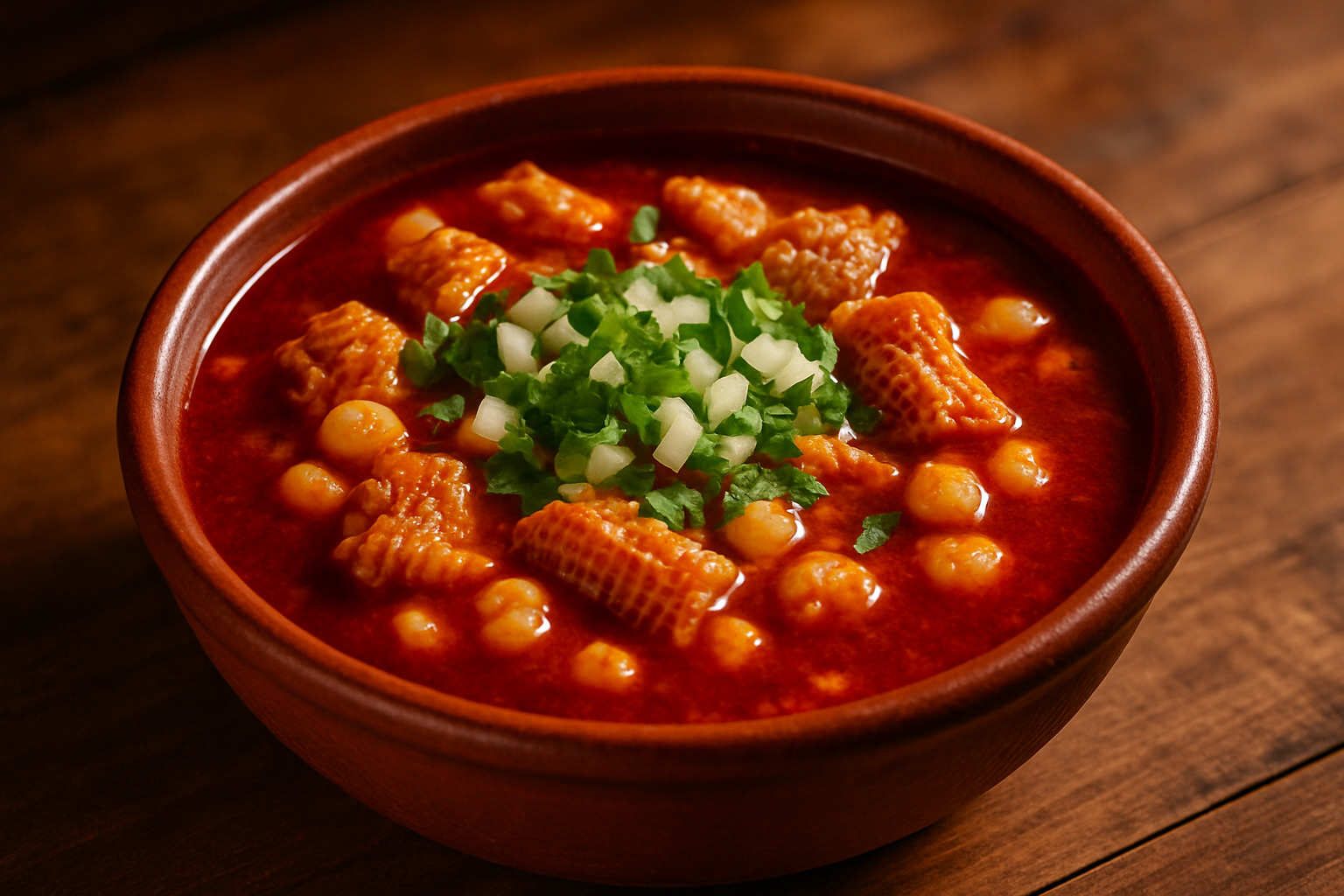
Exploring what is tripe meat through global cuisines reveals a fascinating culinary story that spans every continent. What amazes me most about tripe is how different cultures have transformed this humble ingredient into beloved comfort foods that define their regional identities.
In Mexico, menudo reigns supreme as the ultimate weekend morning dish. This spicy soup combines honeycomb tripe with hominy in a rich red chili broth that requires hours of patient simmering. Mexican families swear by menudo as the perfect hangover cure, and honestly, after trying an authentic bowl in a busy market, I understand why it’s become such a cultural touchstone.
Italy’s trippa alla romana showcases how simple ingredients can create magic. Roman cooks simmer tripe in bright tomato sauce with fresh mint, finishing with a generous shower of sharp Pecorino Romano cheese. The mint might surprise you at first, but it perfectly balances the rich tomato base and gives the dish its distinctive character.
Spain contributes callos a la madrileña, Madrid’s signature comfort food that combines tripe with smoky chorizo, blood sausage, and tender chickpeas. This hearty stew sustained Spanish working families for generations, and today it still fills Madrid’s traditional tavernas with the most incredible aromas.
French cuisine lifts what is tripe meat to an art form with tripes à la mode de Caen. This Norman specialty braises all four types of tripe with calf’s foot, onions, and carrots for up to 10 hours. The dish is so revered that a special brotherhood organizes annual competitions to crown the world’s best version – now that’s dedication to tripe!
In Chinese dim sum restaurants, tripe appears in delicate preparations, often stir-fried with ginger and scallions or steamed with fermented black bean sauce. The Cantonese approach focuses on texture and subtle flavors rather than the bold, hearty preparations found in Western cuisines.
For more international culinary trips, check out our world cuisine exploration guide.
Iconic Soups & Stews Featuring Tripe
The Caribbean brings us Dominican mondongo, a vibrant stew that combines tripe with starchy yuca and sweet plantains in a fragrant sofrito base. This dish perfectly represents how tripe can anchor both nutritious and economical family meals.
Filipino kare kare transforms what is tripe meat into something completely unique – a rich peanut-based stew that traditionally pairs tripe with oxtail and fresh vegetables. The accompanying fermented shrimp paste (bagoong) adds a salty, funky contrast that makes every bite interesting.
Portugal’s tripas à moda do Porto holds such cultural significance that residents of Porto earned the nickname “Tripeiros” (tripe eaters). This comforting stew of tripe and white beans, seasoned with smoky paprika and chouriço sausage, represents Portuguese soul food at its finest.
Greek patsás serves as both comfort food and hangover remedy, combining tripe with pig’s feet and vegetables in a nourishing broth. You’ll find this soup served in specialized late-night tavernas throughout Greece, where locals gather for both the food and the camaraderie.
Creative Modern Uses & Flavor Pairings
Today’s food scene is refinding what is tripe meat can offer beyond traditional preparations. Street food vendors have mastered tacos de tripas, slicing cooked tripe thin and grilling it with onions and peppers until the edges get beautifully crispy.
Contemporary chefs are incorporating diced, cooked tripe into hearty salads where it adds protein and satisfying chewiness, especially when paired with robust vinaigrettes that complement tripe’s mild flavor.
Traditional sausage makers still rely on tripe as natural casings, stuffing them with spiced meat mixtures to create authentic sausages with proper snap and texture.
Italian-inspired pasta dishes showcase how tripe works beautifully in rich tomato-based sauces improved with herbs and wine. The key lies in bold seasonings – garlic, onions, tomatoes, fresh herbs, and good wine all help tripe absorb incredible flavors while masking any lingering odors.
The secret to successful tripe cooking, regardless of the cuisine, is embracing bold flavors and giving the ingredient time to properly absorb all those wonderful seasonings.
Sustainability, Cost & Evolving Popularity
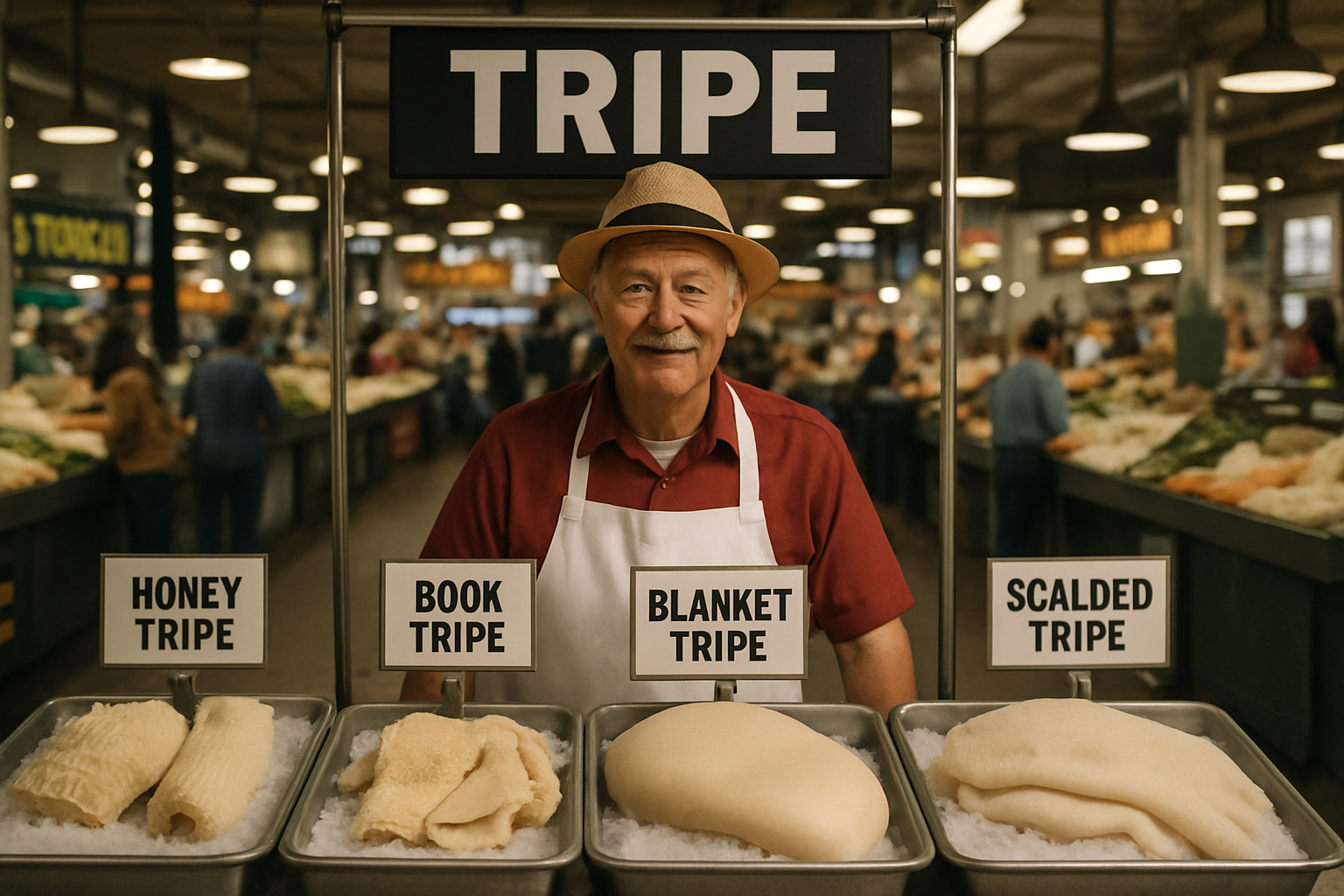
When you understand what is tripe meat in today’s context, you’re looking at one of the most sustainable protein choices available. This humble ingredient represents the heart of nose-to-tail eating – a philosophy that honors the entire animal and dramatically reduces food waste.
Think about it: every time we eat tripe, we’re using something that would otherwise be discarded. No additional animals need to be raised, no extra resources consumed. It’s like getting a nutritional bonus from livestock already being processed for other cuts.
The environmental math is compelling. While premium steaks require the same amount of feed, water, and land as organ meats, tripe costs a fraction of the environmental impact because it’s essentially “free” from a resource perspective.
World Tripe Day on October 24th celebrates this sustainable approach to eating. The date commemorates Samuel Pepys’s 1662 diary entry where he wrote about enjoying a tripe dinner – proving that appreciation for this ingredient has deep historical roots.
Economical & Eco-Friendly Choice
Your wallet will thank you for finding what is tripe meat can offer. At most butcher shops and ethnic markets, tripe costs 50-70% less than chicken breast or ground beef. A pound of cleaned honeycomb tripe often costs less than a single coffee drink, making it one of the most affordable complete proteins available.
This byproduct utilization represents smart resource management. Instead of becoming waste, stomach lining transforms into nutritious meals that have fed families for generations. It’s the ultimate example of “waste not, want not.”
When you choose tripe from grass-fed, pasture-raised animals, you’re supporting regenerative agriculture practices that actually improve soil health and capture carbon from the atmosphere. These farming systems often produce more nutrient-dense organ meats compared to conventional operations.
In many parts of the world, organ meats like tripe provide essential nutrition for communities where every protein source matters. By embracing these foods in affluent markets, we help maintain demand that supports global food security.
History, Decline & Resurgence of What Is Tripe Meat
The story of what is tripe meat meant to different generations reveals fascinating cultural shifts. During the Victorian era, tripe was a beloved staple that crossed class lines. Working families relied on it for affordable nutrition, while even middle-class households enjoyed it regularly.
Britain had over 150 specialized tripe restaurants operating into the 1950s, with the United Cattle Products chain becoming as familiar as any modern fast-food brand. These establishments served tripe and onions, tripe and chips, and countless variations that satisfied millions of diners.
The post-war prosperity of the 1950s and 60s changed everything. As incomes rose, many families abandoned organ meats in favor of premium cuts like steaks and chops. Tripe became associated with hardship and poverty – something you ate when you couldn’t afford “better” options.
This cultural shift nearly killed tripe appreciation in Western countries. Entire generations grew up never tasting it, and knowledge of proper preparation techniques faded from home kitchens.
Today’s modern revival tells a different story. The nose-to-tail movement, led by innovative chefs and sustainable eating advocates, has reframed organ meats as sophisticated, environmentally conscious choices. Food enthusiasts in cities like New York City now seek out authentic tripe preparations as culinary trips rather than economic necessities.
Immigrant communities deserve credit for keeping tripe traditions alive during its darkest decades. Mexican families continued making menudo, Italian grandmothers still prepared trippa, and Asian communities maintained their tripe-based soups and stir-fries. These cultural bridges helped reintroduce tripe to mainstream American palates.
The resurgence reflects broader changes in how we think about food. Modern diners value authenticity, sustainability, and culinary trip – qualities that perfectly align with traditional tripe preparations.
For more information about finding unique dining experiences that celebrate traditional ingredients, visit our guide to interesting places to eat.
Frequently Asked Questions about Tripe
Is tripe meat healthy despite its cholesterol content?
What is tripe meat brings to your plate is actually quite impressive nutritionally, even with its cholesterol content. While that 5-ounce serving does pack 178 mg of cholesterol, you’re also getting a powerhouse of complete proteins, vitamin B12, selenium, and zinc that your body truly needs.
Here’s the encouraging news: modern nutritional science shows that dietary cholesterol doesn’t impact blood cholesterol as dramatically as we once believed for most people. Your liver actually produces most of your body’s cholesterol naturally, adjusting production based on what you eat.
The high-quality protein in tripe supports muscle health and keeps you feeling satisfied longer. That exceptional vitamin B12 content prevents anemia and supports nerve function. The selenium acts as a powerful antioxidant, while zinc boosts your immune system.
That said, if you’re managing cardiovascular conditions or your doctor has specifically advised limiting cholesterol, it’s wise to chat with your healthcare provider about including tripe in your meal rotation.
How long does cleaned tripe last in the refrigerator or freezer?
Fresh, cleaned tripe needs to be used pretty quickly – within 1-2 days when stored in your refrigerator at 40°F or below. This isn’t the ingredient to buy and forget about for a week.
For longer storage, your freezer becomes your best friend. Properly wrapped tripe will maintain quality for 3-4 months when frozen in airtight packaging. I recommend portioning it into recipe-sized amounts before freezing – this makes your future cooking much more convenient.
Cooked tripe dishes give you more flexibility, lasting 3-4 days in the refrigerator when stored in sealed containers. Think of those leftover menudo or Italian tripe preparations that often taste even better the next day.
Always thaw frozen tripe in the refrigerator overnight rather than at room temperature. And remember the 2-hour rule – never leave tripe sitting out at room temperature for more than 2 hours to prevent bacterial growth.
Can I substitute other proteins for tripe in traditional recipes?
While I understand the desire to find substitutes, no protein truly replicates what makes tripe meat special – that unique chewy texture and remarkable ability to absorb flavors like a culinary sponge.
Mushrooms, particularly king oyster mushrooms, come closest in providing that satisfying chewiness. Chicken gizzards offer similar texture and that distinctive organ meat character. Seitan brings chewiness but with a completely different nutritional profile.
For vegetarian options, firm tofu or tempeh can absorb flavors reasonably well, though they lack tripe’s protein density and unique mouthfeel.
But here’s my honest take: these substitutions fundamentally change the dish’s character. Part of truly appreciating traditional tripe preparations like menudo or trippa alla romana involves embracing their distinctive qualities rather than trying to replicate them.
If you’re hesitant about texture, start with dishes where tripe is diced small and well-seasoned. The trip of trying authentic what is tripe meat offers often rewards those willing to step outside their comfort zone.
Conclusion
When people first ask what is tripe meat, they often expect a simple answer. But as we’ve finded together, tripe is so much more than just stomach lining from cattle. It’s a window into centuries of human ingenuity, showing us how our ancestors transformed every part of an animal into nourishing, delicious food.
Think about it – from the busy street vendors serving tacos de tripas in Mexico City to the cozy trattorias ladling out trippa alla romana in Rome, tripe connects us to authentic food cultures around the world. When you’re exploring New York City’s incredible dining scene, you’ll find this same spirit of culinary trip in hidden gems serving traditional dishes that tell stories of immigration, adaptation, and cultural pride.
The beauty of understanding what is tripe meat lies in how it challenges our preconceptions. Yes, it requires patience to prepare properly. Yes, the texture might surprise you at first. But once you taste a perfectly seasoned bowl of menudo on a Sunday morning or savor the rich, tomato-kissed tripe in a Roman osteria, you’ll understand why entire cultures have built comfort food traditions around this humble ingredient.
From a practical standpoint, tripe makes incredible sense for today’s conscious eaters. It delivers exceptional nutrition – more vitamin B12 than most supplements, complete proteins for muscle health, and essential minerals – all while costing less than premium cuts and supporting sustainable nose-to-tail practices.
At The Dining Destination, we’ve seen how ingredients like tripe open doors to authentic culinary experiences that you simply can’t find in mainstream restaurants. These are the findies that transform a simple meal into a memorable story, whether you’re dining in your own kitchen or exploring our carefully curated best food destinations.
The next time you encounter tripe on a menu or in a market, you’re looking at centuries of culinary wisdom. Give it a try – your taste buds (and your sense of trip) will thank you.

